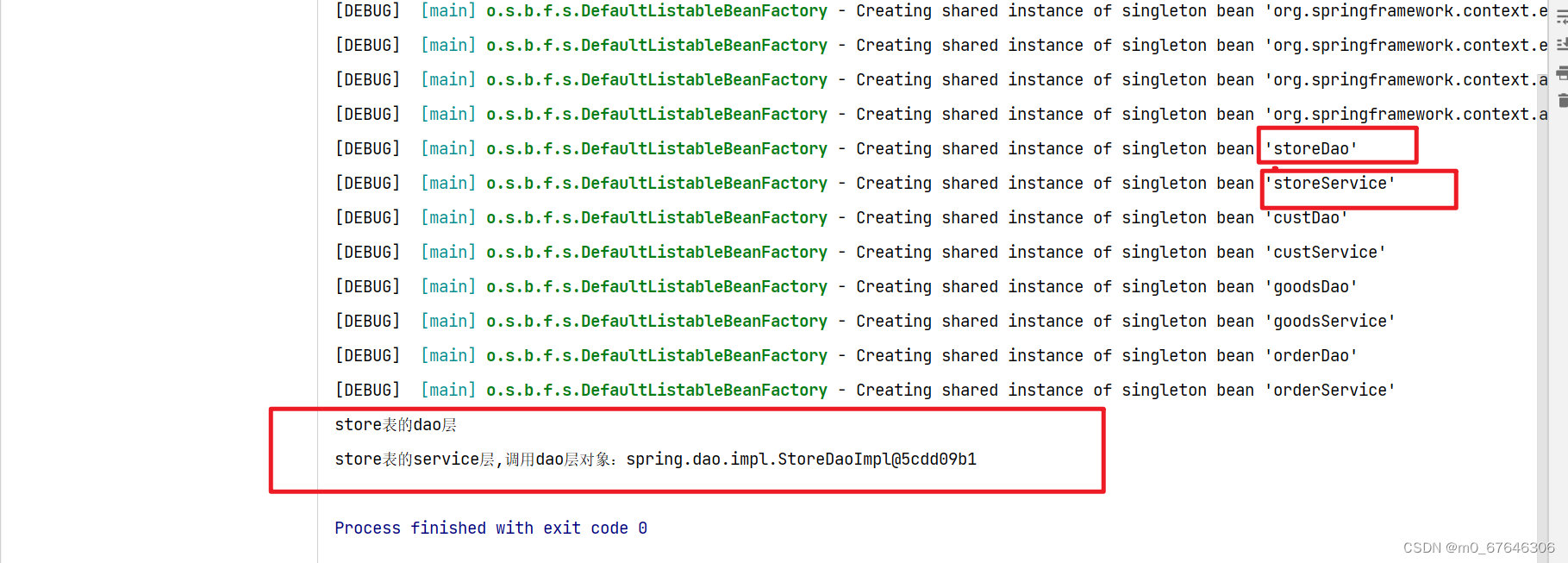1.构造器
(1)Customers实体类
@Data
@NoArgsConstructor
@AllArgsConstructor
public class Customers implements Serializable {
private Integer CustID;
private String CustName;
private String LoginPwd;
private String phone;
private String Email;
private String add;
private String Acc;
}(2)applicationContext.xml配置文件设置
<?xml version="1.0" encoding="UTF-8" ?>
<beans xmlns="http://www.springframework.org/schema/beans"
xmlns:xsi="http://www.w3.org/2001/XMLSchema-instance"
xsi:schemaLocation="http://www.springframework.org/schema/beans
http://www.springframework.org/schema/beans/spring-beans.xsd">
<bean id="custDao" class="spring.dao.CustDaoImpl">
<bean id="custService" class="spring.service.CustServiceImpl">
<constructor-arg name="custDao" ref="custDao"/>
</bean>
(3)Dao层的接口与实现类
接口:

实现类:

(4)Service层的接口和实现类
接口:

实现类:
public class CustServiceImpl implements CustService{
//声名一个Customers实体类的dao层对象
private CustDao custDao;
public CustServiceImpl() {
}
//依赖注入,把交给ioc管理的custDao对象指向为该类的custDao
public CustServiceImpl(CustDao custDao) {
this.custDao = custDao;
}
@Override
public List<Customers> selectAllCusts() {
System.out.println("service-----selectAllCusts()");
//调用custDao对象的selectAllCusts
custDao.selectAllCusts();
return null;
}(5)编写测试类
public class TestCustomers {
// 引入custService对象;
ApplicationContext applicationContext = new
ClassPathXmlApplicationContext("applicationContext.xml");
CustService custService = (CustService) applicationContext.getBean("custService");
@Test
public void testSelectAll(){
//调用custService对象的selectAllCusts方法
custService.selectAllCusts();
}
}(6)运行结果

(7)总结:构造器是在配置文件中就指明了哪个对象注入到哪个类中,
被注入的哪个类只需要,创建一个参数类型是注入对象类型的带参构造方法,来接收注入的对象
这就是为什么Sercice层没像test测试类那样通过解析applicationContext.xml文件来获取对象的原因。
// 引入custService对象;
ApplicationContext applicationContext = new
ClassPathXmlApplicationContext("applicationContext.xml");
CustService custService = (CustService) applicationContext.getBean("custService");2.set方法引入(与构造器方法类似,具体有两点差别)
(1)配置文件(把之前的constructor-arg name标签换成了property)
<bean id="orderDao" class="spring.dao.OrderDaoImpl">
</bean>
<bean id="orderService" class="spring.service.OrderServiceImpl">
<property name="orderDao" ref="orderDao"></property>
</bean>(2)带参的构造方法换成了set方法
//通过set方法引入
public void setOrderDao(OrderDao orderDao){
this.orderDao=orderDao;
}(3)运行结果

(4)总结:set注入方法与构造器方法原理大致相同
除了以上两点,其余代码类似
3.注解(相比于前两种更简便)
(1)配置文件引入组件(会自动扫描你指定的文件夹,通过注解把对象交给IOC管理)
<?xml version="1.0" encoding="UTF-8" ?>
<beans xmlns="http://www.springframework.org/schema/beans"
xmlns:xsi="http://www.w3.org/2001/XMLSchema-instance"
xmlns:context="http://www.springframework.org/schema/context"
xsi:schemaLocation="http://www.springframework.org/schema/beans
http://www.springframework.org/schema/beans/spring-beans.xsd
http://www.springframework.org/schema/context
https://www.springframework.org/schema/context/spring-context.xsd">
<!--注解的组件扫描-->
<context:component-scan base-package="spring"/>(2)Dao层对象storeDao
//注解方式引入
@Repository("storeDao")
public class StoreDaoImpl implements StoreDao {
@Override
public List<Stores> selectAllStore() {
System.out.println("store表的dao层");
return null;
}
}(3)Service层对象storeService
//注解方式将该类交给IOC生成对象为storeService
@Service("storeService")
public class StoreServiceImpl implements StoreService {
//依赖注入
@Autowired
//指明注入的对象name属性
@Qualifier("storeDao")
private StoreDao storeDao;
@Override
public List<Stores> selectAllStores() {
storeDao.selectAllStore();
System.out.println("store表的service层,调用dao层对象:"+storeDao);
return null;
}
}(4)测试类
public class TestStores {
//依赖注入
ClassPathXmlApplicationContext classPathXmlApplicationContext = new ClassPathXmlApplicationContext("applicationContext.xml");
StoreService storeService = (StoreService) classPathXmlApplicationContext.getBean("storeService");
@Test
public void test1() {
//调用storeService对象的selectAllStores()方法
storeService.selectAllStores();
}
}(5)运行结果

(6)总结:依赖于注解的方法要比前两种的方法更为简便
但是具体要用哪一种,根据需求来定。





















 1368
1368

 被折叠的 条评论
为什么被折叠?
被折叠的 条评论
为什么被折叠?








